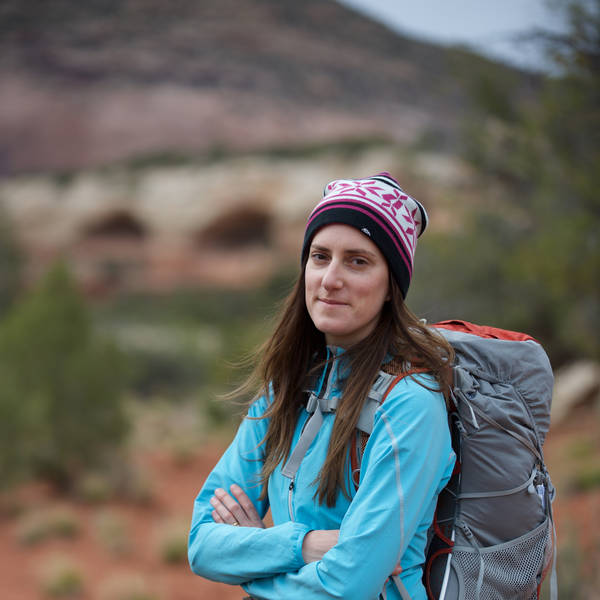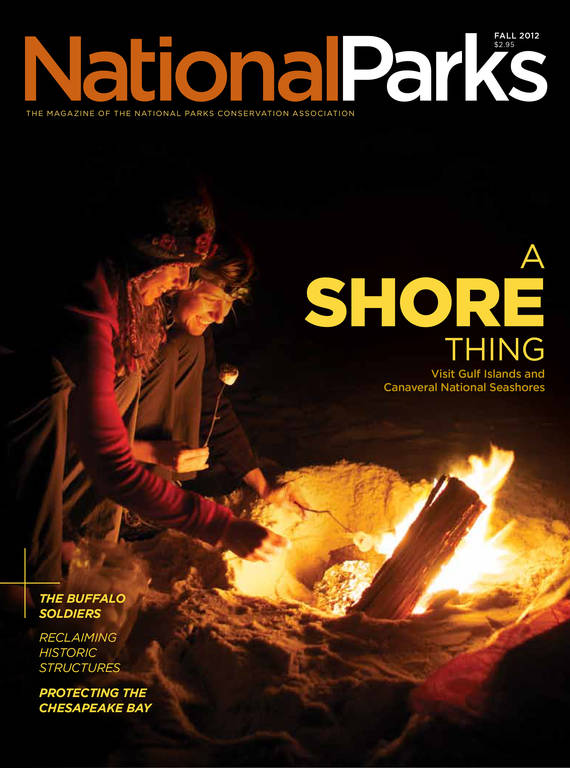Fall 2012
Standing Guard
Meet America’s Buffalo Soldiers—some of the nation’s first park rangers.
On a clear fall day in California in 1903, a group of soldiers and civilians, both African American and Caucasian, gathered in Sequoia National Park. They ate fried chicken, ham and cheese sandwiches, and fresh fruit. They sipped beer and hot coffee and enjoyed the afternoon idyll in what is now one of America’s most storied forests. At the time, it was a remarkably unusual sight.
NPCA @WORK
The occasion for the picnic was the end of a season of hard work. In a summer, local engineers, construction workers, and two troops of Buffalo Soldiers—the Western frontier’s first African-American servicemen—had accomplished what similar crews had taken three years to achieve. Together, they had built five miles of road and the first wagon route into the Giant Forest of Sequoia National Park. Today, the route still leads hundreds of thousands of visitors to some of the largest living organisms in the world.
On assignment in Sequoia and Yosemite National Parks for three summers—1899, 1903, and 1904—the Buffalo Soldiers accomplished many other things, too. They chased away wild-game poachers and foiled sheep herders who illegally let their flocks graze in the park. They also constructed the first trail up 14,500-foot Mt. Whitney, the country’s highest peak at the time, and built an arboretum with trails and benches, which is now considered the first museum in the National Park System.
These men were some of the first national park rangers, but soon after they left, their accomplishments in the parks were largely forgotten. It may be because their stints were short and there were few first-hand accounts of their work, but it’s quite likely that prejudice played a role in erasing their legacy and the broader contributions of African Americans in settling the West.
But now that’s all changing. In the last ten years, several researchers and Park Service staffers have unearthed photographs, muster rolls, and military reports that offer a window into this hidden corner of park history.
Distinguished Service
African Americans fought for the country long before they were known as Buffalo Soldiers. In the late 1700s, about 7,000 black soldiers defended America in the Revolutionary War. In the Civil War, more than 180,000 donned the Union blue to fight for volunteer regiments. Finally, in 1866, Congress established six segregated regiments of enlisted African-American soldiers, which soon consolidated into four: the 24th and 25th Infantry and the 9th and 10th Cavalry.
The Buffalo Soldiers were soon sent to fight battles and keep order in a nation that was still growing and still defining itself. They patrolled the Western frontier, following all the same orders as white cavalrymen. They protected wagons and trains from outlaws, built telegraph lines, improved roads, escorted mail carriers, and fought in more than 125 conflicts with American Indians.
As the legend goes, during these skirmishes, Cheyenne and other Plains tribes gave the Buffalo Soldiers their name, inspired by their hair, which was curly and coarse like the matted cushion between a buffalo’s horns, an animal central to their culture. Even now, the name is seen as a respectful reflection of the esteemed animal, known for its bravery and strength. Though the Buffalo Soldiers and American Indians were often pitted against each other in battle, many letters from Buffalo Soldiers reflect respect for the tribes and ambivalence over fighting cultures that shared a similar history of oppression.
The Buffalo Soldiers also fought overseas. In the Spanish-American War, they stood next to Theodore Roosevelt and his volunteer “Rough Riders” in the Battle of San Juan Hill in Cuba in 1898. Some of the Buffalo Soldiers earned medals of honor, and a few rose to the ranks of officer. Their bravery and accomplishments in battle became sources of pride and hope for African Americans across the country; some historians cite their service as the beginning of the Civil Rights Movement.
A Source of Pride
COVERING GROUND
Although enlisting in the Army posed its own serious risks, it was one of the few places of opportunity for a strong, ambitious black man during a time when discrimination was rampant and lynching was appallingly common. (Only one woman ever served as a buffalo soldier: Cathy Williams was born a slave, posed as a man to enlist in the 38th Infantry, and patrolled the Santa Fe Trail.)
“If you had that kind of sense that you were as good as anyone else, that could get you killed in the South,” says Shelton Johnson, an interpretive ranger in Yosemite National Park who helped revive the story of the Buffalo Soldiers after stumbling upon a historic photo of the soldiers in the research library of Yosemite National Park. “Ironically enough, the safest place for an African-American man [who felt he was as good as any other man] was in the Army.”
The military not only offered room, board, a uniform, a weapon, and a salary of $13 a month, it cultivated a sense of pride in men. Some of these men had been born into slavery, after all, and the rest were born shortly after President Lincoln issued the Emancipation Proclamation.
“The Army was and still is a place of opportunity, and it’s always been ahead of society,” says Brian G. Shellum, author of a two-volume biography of Capt. Charles Young, a Buffalo Soldier and West Point graduate. “The Buffalo Soldiers probably felt more like Americans, like citizens, than [they had] anywhere else.”
Still, the life of any soldier was not easy. They traveled rough country, subsisted on bland rations of beans and bacon, and endured the terror and tedium of war. Though they were paid the same as white soldiers, the Buffalo Soldiers struggled with racial prejudices at every turn. In letters to black newspapers, many Buffalo Soldiers expressed profound ambivalence over removing American Indians from their lands. Escaped slaves often joined tribes, such as the Seminoles in Florida, so many Buffalo Soldiers had American Indian blood themselves. The irony of oppressing another race in the name of one’s own oppressors was not lost on them. But for many, it was the best option in a time when most African Americans had few choices beyond the life of a sharecropper.
The Park’s First Protectors
The Buffalo Soldiers posted in national parks faced particularly challenging work. Between 1891 and 1913, before the Park Service was born, the military was the sole protector of these nascent parks. During the summers of 1899, 1903, and 1904, the duty fell to regiments of Buffalo Soldiers. Over those three years, about 500 men made the 200-plus-mile marches to Yosemite and Sequoia from Monterey, California.
Though the parks had regulations, there were no courts or judges to enforce those regulations, so the soldiers resorted to clever methods of discouragement. In some instances, they would deposit an offending sheepherder at one corner of the park and the herd at the other, 125 miles away.
Despite the challenges, the soldiers managed to keep illegal grazing down, fight forest fires, build trails and roads, and expel poachers who wiped out wildlife at alarming rates when unchecked. It’s easy to imagine that even though the terrain was rugged, these soldiers found solace in the magnificent scenery that surrounded them.
“It is the cavalryman’s paradise,” wrote N.F. McClure of the 5th Cavalry, in the Journal of the U.S. Cavalry Association in 1897. “Food and drink for his horse everywhere. Though the cold of spring and autumn may be biting, though the life may be lonely, though the work may be difficult—still, happy is the soldier whose lines fall amid these scenes of grandeur and sublimity, where nature has put forth her mightiest efforts.”
A Black Officer

Charles Young Buffalo Soldiers National Monument
Colonel Charles Young lived a remarkable life, overcoming racism and injustice to become a respected military officer, park steward and inspirational leader.
See more ›Capt. Charles Young was the third African American to graduate from West Point, one of the first to become a military officer, and the first African-American superintendent of a national park. Young arrived in Sequoia National Park with the 9th Cavalry in the spring of 1903. Most Buffalo Soldier regiments were led by white officers, and his presence caused a stir among locals. But Young quickly proved himself an exceptional leader.
Under his superintendence, the troops finished the road to the Giant Forest, working cooperatively with local white engineers and construction workers. His men also cut down on illegal grazing in the park and poaching of wild game. Young persuaded locals who held claims to 3,877 acres of land within national park boundaries to sell at a fair price. Though Washington bureaucrats didn’t follow through in time (and instead bought the land ten years later), Young’s negotiations were rare and remarkable. So was his unusual commitment to conservation.
“Indeed, a journey through this park and the Sierra Forest Reserve to the Mount Whitney country will convince even the least thoughtful man of the needfulness of preserving these mountains just as they are,” he wrote in a 1903 military report.
At the end of the summer of 1903, Young’s troops, the engineers, and the construction workers were so impressed with his leadership that they proposed naming a tree after him. He declined and suggested that it be named after Booker T. Washington, who heralded the Buffalo Soldiers as standard bearers of the race.
More than 100 years later, a retired curator leafing through an Ohio archive found a photograph of this exact tree, with its Booker T. Washington plaque. Park staff found the tree, and though the original nail remained, the plaque had fallen and been forgotten. Now the tree is known again for the esteemed thought leader, and staff at Sequoia, Yosemite, and the Presidio are researching and sharing a story that had been lost for a century.
The Buffalo Soldier’s Legacy

National Parks
You can read this and other stories about history, nature, culture, art, conservation, travel, science and more in National Parks magazine. Your tax-deductible membership donation of $25 or more entitles…
See more ›Ranger Shelton Johnson shares the Buffalo Soldiers’ story through his impassioned and popular weekly presentation at Yosemite, in which he dons their iconic blue uniform to portray a sergeant stationed in Yosemite in 1903. Some visitors look troubled or upset at the idea that African Americans played an important role in the settling of the West (they formed 10 percent of the military) and the preservation of the national parks.
“The dominant perception is there were no black people in the West,” says Johnson. “By telling the Buffalo Soldiers’ story, we’re countering literally 100 years of absence and everything in our mindset as to who was in the American West.”
It’s a story that park visitors of all colors need to hear. America has never been more diverse, and to engage all Americans—and encourage them to care about these public lands—the Park Service needs to reach out to minorities who haven’t identified with the parks in the past, says Stephen Haller, a historian at Golden Gate National Recreation Area in California.
“The park story is really a more diverse story than we have been led to believe,” says Haller. “The parks have often been perceived as a fairly exclusive ‘white-guy club,’ and as it turns out, it’s not so much—not exclusively. I think that’s something we can all be really happy about.”
About the author
-
 Kate Siber Contributor
Kate Siber ContributorKate Siber, a freelance writer and correspondent for Outside magazine, is based in Durango, Colorado. Her writing has appeared in National Geographic Traveler and The New York Times. She is also the author of “National Parks of the U.S.A.,” a best-selling children’s book.



